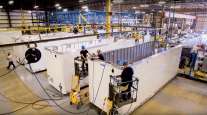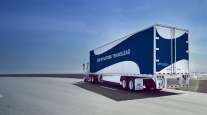March Trailer Orders Total 29,500

U.S. trailer orders for March jumped 36% to top 29,000 as demand roared on and manufacturers began to grapple with the surging costs of key materials.
At the same time, there are delays in getting some components now as trailer makers typically look to boost build rates, experts said.
Orders reached 29,500 compared with 21,663 a year earlier, ACT Research Co. reported, citing preliminary data it will tweak when final results are in.
March posted “a big number,” said Frank Maly, ACT’s director of commercial vehicle transportation analysis and research.
Research company FTR pegged preliminary orders at 27,500, calling March a stout month for orders.
Meanwhile, rising aluminum and steel prices have taken “a big bite, and it has been swift,” Hyundai Translead Chief Sales Officer Glenn Harney told Transport Topics.
Sourcing steel from Mexico and Canada still is possible, Harney said, but the risk of tariffs getting applied “as early as May is a deterrent,” and both countries tie their prices to reflect U.S steel prices.
Still, Hyundai Translead has some orders for 2019.
At Strick Trailers, requests for trailers in 2019 are coming in, “but we are still not in a position to quote these requests due to the volatility in material and component pricing,” Strick Group Chief Sales Officer Charles Willmott said.
“Last week, aluminum pricing went up 10% in less than 10 days,” Willmott said April 17, adding the company’s standard sheet and post van models are 97% North American-sourced, other than the tires.
“Trailer OEMs are squarely in the middle, with margins being eroded and manufacturing efficiencies compromised,” Willmott said.
One carrier is paying attention.
“We are watching that [trailer] market pretty carefully,” said Jeff Cohen, executive vice president of transportation at G&D Integrated.
The company uses dry van trailers, tankers, flatbeds and step-decks. It has purchased in all segments this year, Cohen said. Wabash National Corp. is its primary new-trailer supplier.
The transportation and logistics company offers truckload and intermodal drayage services and has a fleet of about 430 trucks and 2,100 trailers.
Order boards for new van trailers are full through this year, he said, while on the flatbed and tanker sides, it’s seven to eight months out.
Given the growing lead times for new trailers and stronger freight-growth opportunities, the carrier has turned to the used-trailer market to deal with the fluctuations in capacity.
“We have been dabbling a bit more in the used-trailer market than we typically would in order to get some fairly late-model trailers that still have some good life in them. But those markets are tight, too,” Cohen said.
Maly said some trailer makers may not be able to raise production to fulfill orders as much as they previously anticipated, noting some reports of “component challenges” involving axles, suspensions and tires.
One supplier said it was coping with demand fairly normally.
“Unusual specialty orders or unexpected orders with short lead times could result in a short supply delay,” said Steve White, Michelin B2B business planning and strategy manager.
In the last few months, Hendrickson USA — which manufactures air suspension systems and components for heavy duty trucks and trailers — has experienced an unprecedented level of demand, and is working diligently to ramp up plants to accommodate the increase in business, a company executive said.
“When we attended the North American Commercial Vehicle Show in Atlanta back in September, many van OEMs indicated they felt 2018 would be a slower year in comparison to the robust years of 2015 and 2016,” said Jon Jeffries, director of sales at Hendrickson Trailer Commercial Vehicle Systems. “However, within a few weeks of the show, we started to see our order boards go crazy. A mixture of industry regulation for electronic logging devices, increased oil prices, increased financial stimulus from the Tax Cut and Job Act, strong freight demand and a host of other positive economic factors have created a cocktail for record demand for trailers.”
Hendrickson’s backlog is double what it was a year ago, and it has increased its output by 32% since October 2017, he said.
“We’ve taken an all-hands-on-deck approach, and fortunately, we’ve been able to use out-of-the-box thinking to come up with creative solutions for increasing capacity and throughput as we ramp to record levels,” Jeffries said.
At Stoughton Trailers, customers are asking about space for early 2019, said David Giesen, vice president of sales. “But very little is in place in order to accurately price Q1 2019.”
Giesen’s concern is other industries will start to put pressure on the same sources Stoughton uses, driving up costs and further affecting availability, he said.
Another trailer maker, agreed materials tight from a supply standpoint and are increasing in cost almost weekly now.
“The cost increases are driven by the tight supply in the marketplace and also to some degree from the new tariffs,” said Craig Bennett, senior vice president of sales for Utility Trailer Manufacturing Co.
At the same time, Utility’s order board has never been stronger, he said. “We expect to see strong trailer demand into next year.”
One motor carrier refreshed its trailers heavily ahead of the current cycle.
“Our trailer fleet is younger than most of our competitors’, which will buy us some time before we have to get back in the trailer-replacement cycle,” said Brian Matthews, vice president of operations at truckload carrier American Central Transport.
“Even with some truck fleet growth, our trailer/truck ratio is positioned to handle net gains through 2018,” he added. The carrier has 350 trucks and 1,050 trailers.
On its latest trailers, ACT spec’d additional driver features, including a step bar to make mounting and dismounting the trailer easier for the driver and a grab handle on the door, he said.
Any order in 2019 will come with the same driver features.
“We might look at additional reinforcement to prevent punctures from forklifts,” Matthews said.




